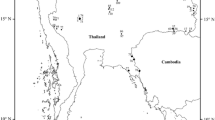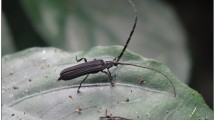Abstract
To investigate patterns of geographical and ecological separation among morphologically similar, closely related species of black flies, we integrated ecological, geographical, and phylogenetic information, based on multiple gene sequences, for 12 species in the subgenus Gomphostilbia in Thailand. Molecular characters supported the monophyly of the Simulium ceylonicum species group, but not of the Simulium batoense species group, suggesting that revisionary work is needed for the latter. Both ecological and geographical isolation of similar taxa were revealed. Stream velocity and altitude were among the principal ecological factors differing between closely related species. Most closely related species in the subgenus Gomphostilbia overlap geographically, suggesting the possibility of sympatric speciation driven by ecological divergence. Geographical isolation via dispersal also might have contributed to species divergence, while Pleistocene climate changes possibly influenced population genetic structure, demographic history, and speciation of some members of the subgenus.





Similar content being viewed by others
References
Adler, P. H. (1988). Ecology of black fly sibling species. In K. C. Kim & R. W. Merritt (Eds.), Black flies: ecology, population management, and annotated world list (pp. 63–76). University Park: Pennsylvania State University Press.
Adler, P.H. & Crosskey. R.W. (2012). World blackflies (Diptera: Simuliidae): a comprehensive revision of the taxonomic and geographical inventory [2012]. http://entweb.clemson.edu/biomia/pdfs/blackflyinventory.pdf Accessed 25 April 2012.
Adler, P. H., & Kim, K. C. (1984). Ecological characterization of two sibling species, IIIL-1 and IS-7, in the Simulium vittatum complex (Diptera: Simuliidae). Canadian Journal of Zoology, 62, 1308–1315.
Adler, P. H., & McCreadie, J. W. (1997). The hidden ecology of black flies: Sibling species and ecological scale. American Entomologist, 43, 153–161.
Boakye, D. A., Back, C., Fiasorgbor, G. K., Sib, A. P. P., & Coulibaly, Y. (1998). Sibling species distributions of the Simulium damnosum complex in the West African Onchocerciasis Control Programme area during the decade 1984–93, following intensive larviciding since 1974. Medical Veterinary and Entomology, 12, 345–358.
Cannon, C. H., & Manos, P. S. (2003). Phylogeography of the Southeast Asian stone oaks (Lithocarpus). Journal of Biogeography, 30, 211–226.
Carstens, B. C., & Knowles, L. L. (2007). Shifting distributions and speciation: Species divergence during rapid climatic change. Molecular Ecology, 16, 619–627.
Conflitti, I. M., Kratochvil, M. J., Spironello, M., Shields, G. F., & Currie, D. C. (2010). Good species behaving badly: non-monophyly of black fly sibling species in the Simulium arcticum complex (Diptera: Simuliidae). Molecuar Phylogenetics and Evolution, 57, 245–257.
Coyne, J. A., & Orr, H. A. (2004). Speciation. Sunderland: Sinauer.
Farris, J. S., Källersjö, M., Kluge, A. G., & Bult, C. (1995). Testing significance of incongruence. Cladistics, 10, 315–319.
Gathorne-Hardy, F. J., Syaukani, Davies, R. G., Eggleton, P., & Jones, D. T. (2002). Quaternary rainforest refugia in South-East Asia: Using termites (Isoptera) as indicators. Biological Journal of the Linnean Society, 75, 453–466.
Graham, C. H., Ron, S. R., Santos, J. C., & Schneider, C. J. (2004). Integrating phylogenetics and environmental niche models to explore speciation mechanisms in dendrobatid frogs. Evolution, 58, 1781–1793.
Haffer, J. (1969). Speciation in Amazonian forest birds. Science, 165, 131–137.
Huelsenbeck, J. P., & Ronquist, F. R. (2001). MRBAYES: Bayesian inference of phylogeny. Bioinformatics, 17, 754–755.
Jitklang, S., Kuvangkadilok, C., Baimai, V., Takaoka, H., & Adler, P. H. (2008). Cytogenetics and morphotaxonomy of the Simulium (Gomphostilbia) ceylonicum species group (Diptera: Simuliidae) in Thailand. Zootaxa, 1917, 1–28.
Johnson, N. K., & Cicero, C. (2004). New mitochondrial DNA data affirm the importance of Pleistocene speciation in North American birds. Evolution, 58, 1122–1130.
Joy, D. A., & Conn, J. E. (2001). Molecular and morphological phylogenetic analysis of an insular radiation in Pacific black flies (Simulium). Systematic Biology, 50, 18–38.
Joy, D. A., Craig, D. A., & Conn, J. E. (2007). Genetic variation tracks ecological segregation in Pacific island black flies. Heredity, 99, 452–459.
Knowles, L. L. (2001). Did the Pleistocence glaciations promote divergence? Tests of explicit refugial models in montane grasshoppers. Molecular Ecology, 10, 691–701.
Kuvangkadilok, C., & Takaoka, H. (2000). Taxonomic notes on Simuliidae (Diptera) from Thailand: description of a new species and new distributional records of nine known species. Japanese Journal of Tropical Medicine and Hygiene, 28, 167–175.
Kuvangkadilok, C., Boonkemtong, C., & Phayuhasena, S. (1999). Distribution of the larvae of blackflies (Diptera: Simuliidae) at Doi Inthanon National Park, northern Thailand. The Southeast Asian Journal of Tropical Medicine and Public Health, 30, 328–337.
Kuvangkadilok, C., Lualon, U., & Baimai, V. (2008). Cytotaxonomy of Simulium siamense Takaoka and Suzuki (Diptera: Simuliidae) in Thailand. Genome, 51, 972–987.
Mayr, E. (1963). Animal species and evolution. Cambridge: Harvard University Press.
Mayr, E., & O’Hara, R. J. (1986). The biogeographic evidence supporting the Pleistocene forest refuge hypothesis. Evolution, 40, 55–67.
McCreadie, J. W., & Adler, P. H. (1998). Scale, time, space, and predictability: species distributions of preimaginal black flies (Diptera: Simuliidae). Oecologia, 114, 79–92.
McCreadie, J.W., Adler, P.H., Grillet, M.E. & Hamada, N. (2006). Sampling statistics in understanding distributions of black fly larvae (Diptera: Simuliidae). Acta Entomologica Serbica Supplement, 89–96.
Morgan, K., Linton, Y., Somboon, P., Saikia, P., Dev, V., Socheat, D., & Walton, C. (2010). Inter-specific gene flow dynamics during the Pleistocene-dated speciation of forest-dependent mosquitoes in Southeast Asia. Molecular Ecology, 19, 2269–2285.
Morin, P. J. (1999). Community ecology. Malden: Blackwell Science.
Nylander, J.A.A. (2004). MrModeltest 2.2. Program distributed by the author. Evolutionary Biology Centre, Uppsala University, Sweden.
O’Loughlin, S., Okabayashi, T., Honda, M., Kitazoe, Y., Kishino, H., Somboon, P., Sochantha, T., Nambanya, S., Saikia, P. K., Dev, V., & Walton, C. (2008). Complex population history of two Anopheles dirus mosquito species in South Asia suggests the influence of Pleistocene climate change rather than human-mediated effects. Journal of Evolutionary Biology, 21, 1555–1569.
Orr, M. R., & Smith, T. B. (1998). Ecology and speciation. Trends in Ecology & Evolution, 13, 502–505.
Palmer, R. W., & Craig, D. A. (2000). An ecological classification of primary labral fans of filter feeding black fly (Diptera: Simuliidae) larvae. Canadian Journal of Zoology, 78, 199–218.
Peterson, A. T., Soberón, J., & Sánchez-Cordero, V. (1999). Conservatism of ecological niches in evolutionary time. Science, 285, 1265–1267.
Phasuk, J., Chanpaisaeng, P., Adler, P. H., & Courtney, G. W. (2005). Chromosomal and morphological taxonomy of larvae of Simulium (Gomphostilbia) (Diptera: Simuliidae) in Thailand. Zootaxa, 1052, 49–60.
Phayuhasena, S., Colgan, D. J., Kuvangkadilok, C., Pramual, P., & Baimai, V. (2010). Phylogenetic relationships among the black fly species (Diptera: Simuliidae) of Thailand based on mult ple gene sequences. Genetica, 138, 633–648.
Posada, D. (2008). jModelTest: Phylogenetic model averaging. Molecular Biology and Evolution, 25, 1253–1256.
Pramual, P., & Kuvangkadilok, C. (2009). Agricultural land use and black fly (Diptera: Simuliidae) species richness and species assemblages in tropical streams, Northeastern Thailand. Hydrobiologia, 625, 173–184.
Pramual, P., & Tangkawanit, U. (2008). A new species of Simulium (Gomphostilbia) (Diptera: Simuliidae) from northeastern Thailand. Medical Entomology and Zoology, 59, 297–303.
Pramual, P., & Wongpakam, K. (2010). Seasonal variation of black fly (Diptera: Simuliidae) species diversity and community structure in tropical streams of Thailand. Entomological Science, 13, 17–28.
Pramual, P., & Wongpakam, K. (2011). Cytogenetics of Simulium siamense Takaoka and Suzuki, 1984 (Diptera: Simuliidae) in northeastern Thailand. Aquatic Insects, 33, 171–184.
Pramual, P., Kuvangkadilok, C., Baimai, V., & Walton, C. (2005). Phylogeography of the black fly Simulium tani (Diptera: Simuliidae) from Thailand as inferred from mtDNA sequences. Molecular Ecology, 14, 3989–4001.
Pramual, P., Wongpakam, K., & Adler, P. H. (2011a). Cryptic biodiversity and phylogenetic relationships revealed by DNA barcoding of Oriental black flies in the subgenus Gomphostilbia (Diptera: Simuliidae). Genome, 54, 1–10.
Pramual, P., Kongim, B., & Nanork, P. (2011b). Phylogeography of Simulium siamense Takaoka and Suzuki complex (Diptera: Simuliidae) in Thailand. Entomological Science, 14, 428–436.
Rambaut, A. & Drummond, A.J. (2004). Tracer 1.3. http://beastbioedacuk/Tracer. Accessed 27 May 2010.
Rodriguez, R., Oliver, J. L., Marin, A., & Medina, J. R. (1990). The general stochastic model of nucleotide substitution. Journal of Theoretical Biology, 142, 485–501.
Rothfels, K. (1989). Speciation in black flies. Genome, 32, 500–509.
Schluter, D. (1998). Ecological causes of speciation. In D. Howard & S. Berlocher (Eds.), Endless forms: Species and speciation (pp. 114–129). New York: Oxford University Press.
Schluter, D. (2001). Ecology and the origin of species. Trends in Ecology & Evolution, 16, 372–380.
Simon, C., Frati, F., Beckenbach, A., Crespi, B., Liu, H., & Flook, P. (1994). Evolution, weighting, and phylogenetic utility of mitochondrial gene sequences and a compilation of conserved polymerase chain reaction primers. Annals of the Entomological Society of America, 87, 651–701.
Swofford, D. L. (2002). PAUP*: Phylogenetic analysis using parsimony (*and other methods). Version 4.b.10. Sunderland: Sinauer.
Takaoka, H., & Choochote, W. (2004). A list of and keys to black flies (Diptera: Simuliidae) in Thailand. Tropical Medicine and Health, 32, 189–197.
Takaoka, H., & Davies, D. M. (1995). The black flies (Diptera: Simuliidae) of West Malaysia. Fukuoka: Kyushu University Press.
Takaoka, H., & Suzuki, H. (1984). The blackflies (Diptera: Simuliidae) from Thailand. Japanese Journal of Sanitary Zoology, 36, 7–45.
Takaoka, H., Srisuka, W., & Saeung, A. (2010). Description of the female of Simulium (Gomphostilbia) gombakense (Diptera: Simuliidae) from Thailand. Medical Entomology and Zoology, 61, 111–114.
Takaoka, H., Sofian-Azirun, M., Hashim, R., & Ya’cob, Z. (2011). Two new species of Simulium (Gomphostilbia) (Diptera: Simuliidae) from Peninsular Malaysia, with keys to Peninsular Malaysian members of the Simulium ceylonicum species-group. ZooKeys, 118, 53–74.
Tamura, K., & Nei, M. (1993). Estimation of the number of nucleotide substitutions in the control region of mitochondrial DNA in humans and chimpanzees. Molecular Biology and Evolution, 10, 512–526.
Thanwisai, A., Kuvangkadilok, C., & Baimai, V. (2006). Molecular phylogeny of black flies (Diptera:Simuliidae) from Thailand, using ITS2 rDNA. Genetica, 128, 177–204.
Thompson, J. D., Gibson, T. J., Plewniak, F., Jeanmougin, F., & Higgins, D. G. (1997). The ClustalX windows interface: Flexible strategies for multiple sequence alignment aided by quality analysis tools. Nucleic Acids Research, 24, 4876–4882.
Weins, J. J. (2004). Speciation and ecology revisited: phylogenetic niche conservatism and the origin of species. Evolution, 58, 193–197.
Woodruff, D. S. (2003). Neogene marine transgressions, palaeogeography and biogeographic transitions on the Thai-Malay Peninsula. Journal of Biogeography, 30, 551–567.
Zhang, Y. (2006). Balancing food availability and hydrodynamic constraint: Phenotypic plasticity and growth in Simulium noelleri blackfly larvae. Oecologia, 147, 39–46.
Zhang, Y., & Malmqvist, B. (1996). Relationships between labral fan morphology, body size and habitat in North Swedish blackfly larvae (Diptera: Simuliidae). Biological Journal of the Linnean Society, 59, 261–280.
Acknowledgments
This work was supported financially by the Thailand Research Fund, Commission on Higher Education and Mahasarakham University (MRG5380053). We thank J. Dodgson (Mahasarakham University, Thailand) for comments on an earlier version of the manuscript.
Conflict of interest
The authors declare that they have no conflict of interest.
Author information
Authors and Affiliations
Corresponding author
Rights and permissions
About this article
Cite this article
Pramual, P., Kuvangkadilok, C., Jitklang, S. et al. Geographical versus ecological isolation of closely related black flies (Diptera: Simuliidae) inferred from phylogeny, geography, and ecology. Org Divers Evol 12, 183–195 (2012). https://doi.org/10.1007/s13127-012-0092-4
Received:
Accepted:
Published:
Issue Date:
DOI: https://doi.org/10.1007/s13127-012-0092-4




